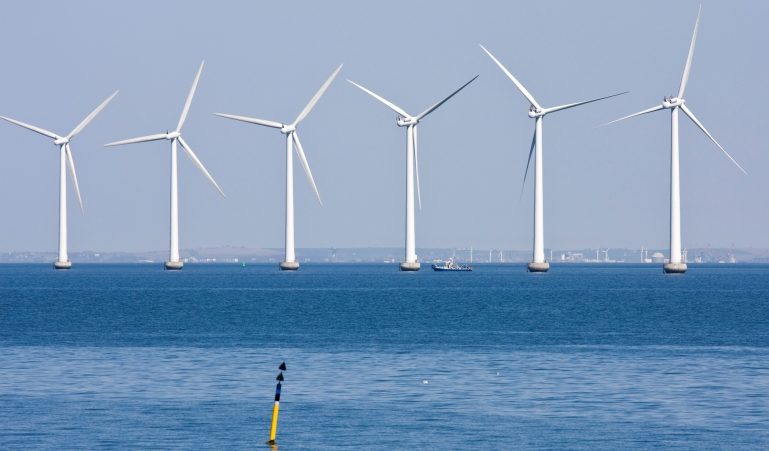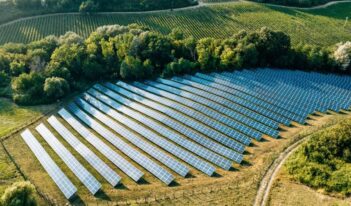
Offshore wind developers face regulatory approval challenges.
U.S. Secretary of the Interior Deb Haaland announced in October that to further the Biden Administration’s goal of doubling offshore wind power generation in the United States by 2030, the Bureau of Ocean Energy Management (BOEM), an agency within the Interior Department, will “hold up to seven new offshore lease sales by 2025” for offshore wind projects.
But building these offshore wind farms may not be smooth sailing.
Although legislators in the United States are pushing to increase offshore wind capacity to move the country toward a clean energy system and meet global climate goals, federal environmental laws and the Interior Department’s own regulations could stand in the way of coastal wind farms.
Before any offshore turbines are constructed, regulators and developers must navigate Interior Department regulations and the National Environmental Policy Act (NEPA). Under federal law, lease areas must be researched and approved before they are auctioned. Even then, construction plans must comply with federal regulations and undergo a process of seeking public comments.
BOEM has already undertaken the first step in identifying areas “most suitable” for offshore wind farms. Of the seven potential sites announced by Haaland, four are along the Atlantic Coast, two are along the Pacific, and one is along the Gulf of Mexico.
These sites, according to BOEM, will be auctioned off to interested developers by 2025. Once developers gain control over a site, however, they will not have complete freedom to construct wind farms. Instead, they will receive an exclusive right to develop the offshore areas but only after submitting plans to the Interior Department for regulatory approval.
These plans, known as Construction and Operations Plans and Site Assessment Plans, must comply with NEPA and other federal environmental protection laws, which require submitting detailed information of how the proposed offshore facilities will affect the surrounding environment. BOEM, before approving any project, will need to subject the proposed plans to environmental and technical reviews, as well as to multiple rounds of public commenting.
A recent example of the difficulties faced by developers seeking regulatory approval is Vineyard Wind, a wind farm projected to be built off the coast of Massachusetts.
Although BOEM approved the project in May 2021, the site’s regulatory approval process began in 2009 when BOEM started evaluating potential lease sites. The auction for Vineyard’s lease was held in 2015, the developers submitted their proposed construction plans in 2017, and BOEM submitted an environmental impact statement report in 2018. The proposal received over 3,500 comments from fishermen, agencies, and interested stakeholders.
Even after BOEM granted Vineyard Wind final approval in 2021, the project still prompted lawsuits that continue to threaten the project’s survival.
For example, members of the fishing industry petitioned a federal court to review the approval and argued that the Interior Department violated NEPA and other environmental statutes.
A solar company filed a different lawsuit challenging the approval for aesthetic reasons as well as for federal statutory violations. In yet another lawsuit, Massachusetts residents challenged the approval for failing to consider the detrimental effect the project will have on whales.
The pending lawsuits against Vineyard Wind, as well as its multi-year process in reaching approval, may serve as a template for future projects. Vineyard’s successes or failures could affect not only the seven sites the Interior Department has earmarked, but also the dozen or so other offshore projects reportedly awaiting federal approval.
Discussing reasons for the regulatory delays, Iulia Georgiu, energy reporter for Utility Dive, has noted that one issue preventing federal approvals—and a potential solution—revolves around staffing at BOEM. Georgiu found that, in 2020, BOEM was understaffed and lacked the resources to manage the many proposed projects awaiting approval in the queue.
President Joseph R. Biden has increased BOEM’s renewable energy yearly budget by $17.4 million, totaling $45.8 million for the 2022 fiscal year. The U.S. Army Corps of Engineers is also providing “additional scientific and technical resources” to BOEM to evaluate proposals, as a result of an executive order from Biden on climate.
Whether or not this increase in funding and resources will clear BOEM’s permitting backlog remains to be seen.
Nonetheless, BOEM offered its own guidance to developers to increase the likelihood of approval. BOEM emphasized that developers, in their proposals, should highlight and outline the infrastructural, environmental, and socioeconomic benefits from their projects. Examples of these benefits include offshore wind farms generating energy near dense population centers, producing less greenhouse gas emissions relative to other power generation sources, and providing benefits to local economies.
Overcoming these regulatory hurdles may be crucial for the Biden Administration’s goal to achieve a net zero economy by 2050. As Jennifer Granholm, Secretary of the U.S. Department of Energy, has noted, “harnessing the incredible potential that exists within offshore wind energy is an essential piece of reaching a net-zero carbon future.”



